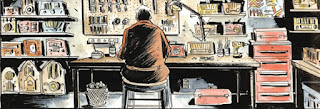 Cometh the hour, cometh the latest comics review, with examples of graphic pleasure that illustrate – since this is sometimes still needed – just how versatile the medium is.
Cometh the hour, cometh the latest comics review, with examples of graphic pleasure that illustrate – since this is sometimes still needed – just how versatile the medium is.
First up, a two-part retelling of the iconic German Expressionist film, The Cabinet of Dr Caligari. with script and art from Diego Olmos, published by Amigo Comics.
Robert Wiene’s original film was intended as a devastating damnation of the imperial German establishment that had led the country into the catastrophe of war in 1914, but against a context of new global sabre rattling and populist nationalism, it has an uncomfortable prescience.
A faithful adaptation of the film, it’s told in black and white throughout, presumably with the aim of capturing the disorienting and highly experimental nature of the film.
Hopefully, it will introduce more viewers to the cinematic masterpiece that gave rise to it, but otherwise one wonders if rethinking the visual look might not have allowed it to have a greater impact.
Also with a sense of echoing our troubled times is Royal City from Jeff Lemire, who is both penning and drawing this new story about a dysfunctional family in a dysfunctional North America.
 |
| A panel from Royal City |
Against a background of changing industrial times, one family finds itself forced to look at an uncomfortable past full of ghosts.
An excellent double-sized issue launched the work, giving time to establish the central background and then leave the reader with plenty of questions. and a sense of unease.
Depending on where Lemire takes everything, this new series from Image has the potential to be very big indeed.
From the pen of Kim Newman comes Anno Dracula – 1895: Seven Days in Mayhem, an original Titan comic instalment in his ongoing series of novels.
At the back of the first issue of this steampunk vampiric romp, there’s a handy timeline of titles so that we can see this comes after the first Anno Dracula novel and before Anno Dracula 1899 and Other Stories, which was published three months ago, which itself comes before Anno Dracula: the Bloody Red Baron.
As an aside, this also shows that a new novel, Anno Dracula 1999: Daikaiju is slated for later this year.
Anyway, this is the expected fun, with words from Newman himself and artwork by Paul McCaffrey.
It’s easy on the eye and has all the fun – including the alternate history references that help to make the novels such a thoroughly entertaining and satisfying read.
The second issue arrived at the same time as the first and ensured that the start was no fluke.
American Gods is Neil Gaiman’s award-winning novel from 2001, which takes as its central idea a battle for supremacy between the old American gods and those brought to the United States by immigrants to those shores from their original homes, and the ‘new gods’ of technology and consumerism.
A fabulous read, it now has a new life as a comic from Dark Horse, with art by Scott Hampton accompanying Gaiman’s own text. Unlike Anno Dracula, this doesn’t constitute a new entry in a particular universe – although it does diverge from the novel in some ways – but it’s good and welcome anyway.
And of course, this is at the same time as a new TV version of the same novel has debuted on Amazon Prime in the UK.
Ricky Whittle makes an impressive start as the strong, silent Shadow Moon, with Ian McShane as Mr Wednesday – otherwise known as Odin – doing a spot of inevitable scene stealing as we got under way.
But such contrasts are part of why the pair spark so well from their first scene together.
As has become the norm for the box set generation, it takes time to establish mood and context – and thank goodness for that. Broodingly atmospheric with some stunning visuals, this promises to be a stunningly good watch.
Bill Willingham’s The Greatest Adventure sees the creator and writer of Fables bring together a group of Edgar Rice Burroughs’s heroes in a brand new adventure that involves saving the Earth.
With artwork by Cezar Razek, the first issue gave us a pacy and entertaining introduction to the premise.
Published by Dynamite comics, it’s going to be interesting to see how Willingham develops this and whether it will be a straightforward romp or have some of the heft of Fables.
Given the success of that previous work, will simply entertaining be enough for an entry on the Willingham CV?
We can but wait and see.
So, an entertaining selection. With the exception of Royal City, all take their inspiration from elsewhere – either from earlier works by the same writers or from even earlier works by other creatives.
What that means in terms of these projects ultimately remains to be seen, but while there might always be a fear that some of this is simply reinventing the wheel, they also give us an insight into how mythology works and grows in our modern, digital era.



No comments:
Post a Comment